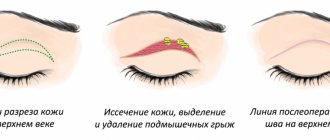Edema or chemosis of the conjunctiva: causes and treatment
Conjunctival chemosis is severe swelling of the mucous membrane of the eye, which protects the organs of vision from adverse environmental factors (dirt, dust, foreign objects). Also, the function of the conjunctiva is to nourish the tissues of the eyeball to prevent it from drying out.
If the protective abilities of the mucous membrane of the eye are impaired for various reasons, then the risk of developing conjunctival chemosis increases. The disease begins with the appearance of swelling, redness, and hemorrhages of the eye shell.
Swelling can reach large sizes, first spreading to the cornea, and then causing the organ of vision to protrude from the palpebral fissure.
Causes
The conjunctival membrane is a layered tissue consisting of a tarsal part, which is tightly adjacent to the eyeball, and a bulbar part, which is not tightly adjacent. Both fabrics are connected to each other by a transitional fold.
There are cavities between the bulbar tissue and the eye, so it rises slightly.
The main inflammatory process when the conjunctiva is damaged occurs in the fold between the tarsal and bulbar tissues, because the healing eye tissues penetrate there poorly and microbes are protected from them.
The main reasons leading to severe swelling of the conjunctiva are:
- use of certain medications;
- swelling of the eyelids;
- barley;
- inflammation of the conjunctiva;
- phlegmon of the eye;
- congestion in the organs of vision;
- excessively dry and dusty climate outdoors or indoors;
- microtrauma of the eye;
- exposure to the mucous membrane of aggressive elements included in cleaning and detergent substances;
- tumors of various types localized in the bulbar region;
- work in a hazardous industry where a person is constantly in contact with harmful chemicals.
If chemosis becomes a consequence of severe forms of conjunctivitis, then purulent discharge and bacterial agents accumulate under the edematous membrane, leading to the formation of ulcers on the cornea. This form of the disease requires long-term and strong treatment.
Chemosis is most often observed in only one eye, but in some cases a bilateral form of the disease is possible, which significantly complicates the treatment process. In this case, a person experiences pronounced painful sensations, and his vision is constantly blurred.
Symptoms
At the beginning of the disease, it is almost impossible to establish chemosis, since the inflammatory process is still weakly expressed, and purulent discharge is just beginning to accumulate between the eye and the conjunctiva.
But over time, if left untreated, the disease makes itself felt with the following signs:
- itchy sensations in the eyes;
- pain and burning;
- swelling of the conjunctiva (small at first, then the mucous membrane begins to protrude beyond the eye);
- purulent discharge from the affected organ of vision;
- the appearance of fog or veils before the eyes;
- closing the eyelids causes severe pain;
- impaired visual acuity.
The conjunctiva always experiences maximum stress and suffers from the effects of unfavorable environmental factors, which can provoke the development of inflammatory and infectious processes.
If you do not pay attention to redness, slight swelling of the mucous membrane of the eye, and do not treat conjunctivitis, it can provoke the appearance of chemosis, sometimes immediately in a severe form.
Destructive processes begin to progress, as a result of which vision may not subsequently be restored or, at best, will return only partially.
Diagnostics
But for the correct choice of treatment tactics, the ophthalmologist must interview the patient and prescribe the following studies:
- Ophthalmoscopy.
- Biomicroscopy.
- Determination of visual acuity (visometry).
- Examination of scrapings from the conjunctiva to identify an infectious agent.
After studying the full clinical picture, the doctor decides on the choice of treatment method.
Therapy
To treat conjunctival chemosis, you must consult an ophthalmologist. He will select an individual course of therapy, which includes ointments, tablets, and eye drops. The choice of medications directly depends on the causes of chemosis.
Drug therapy is prescribed depending on the etiology of the disease. If swelling of the conjunctiva is caused by exposure to allergens, then treatment is carried out with the help of antiallergic and vasoconstrictor drugs (but you must first determine what the person is allergic to and eliminate the allergen). Antihistamines include Tavegil and Claritin.
If conjunctival chemosis develops after blepharoplasty, the treatment is prescribed the same as for the development of the disease as a result of exposure to a viral or bacterial infection.
Antiviral drugs are prescribed, which include Indoxuridine, Interferon, Acyclovir, Poludan. These drugs are especially effective at the very beginning of the development of the disease.
Antibacterial drugs Okamicin, Gentamicin, Floxal, Tobramycin have a good effect. They work very well when the mucous membrane is damaged by bacteria.
Depending on the degree of damage, various combinations of these drugs in different dosages can be used. Therefore, only a doctor should select medications for the treatment of chemosis of the conjunctival membrane of the eye, as well as develop a regimen for their use!
When is surgery necessary?
In the presence of severe conjunctival chemosis, it is often impossible to cure it only with the help of medications, therefore, to eliminate the pathology, surgical techniques are used, during which the affected eye tissue is excised. Contraindications to surgical intervention are:
- stye on the inside of the eyelid;
- eye tumors;
- abscesses of the eyelid;
- exophthalmos.
In other cases, in the absence of contraindications, the inflamed tissues of the mucous membrane of the eye are removed.
Folk remedies
Along with medications in the treatment of conjunctival chemosis, alternative medicine can be used, but only after prior consultation with your doctor.
The table shows the most popular and effective folk recipes for eliminating swelling of the conjunctiva.
| Folk remedy. | Mode of application. |
| Honey drops. | Half a teaspoon of high-quality natural honey is diluted in 200 ml of boiled water until completely dissolved. The resulting solution is used for instillation into the eyes twice a day, a drop in each eye. |
| Chamomile. | Brew two tablespoons of dry medicinal chamomile with a glass of boiling water, place in a water bath and simmer for half an hour, then cool and filter. Cotton pads are moistened in the resulting decoction and applied to the eyes 4-6 times a day for 7-10 minutes. Chamomile is an excellent antiseptic and eliminates inflammation well. |
| Marshmallow root. | Pour 3 tablespoons of dried product into a glass of warm water and leave in a thermos for 8 hours. Then the broth is filtered and used for medicinal lotions 4 times a day. |
Prevention
To prevent chemosis, you need to follow a number of simple eye hygiene rules.
They boil down to the following:
- The organs of vision must be protected from dust, dirt, foreign objects, excessive exposure to sunlight, and microtrauma.
- You should not stay in front of the TV or computer monitor for a long time, straining your eyes.
- If there is a need to constantly work at the computer, then you need to take a break every half hour, doing a little eye gymnastics (blink intensely for 30 seconds, rotate your eyes in all directions). During this time, the conjunctiva will rest, and the tear fluid will moisten it and remove foreign objects from the eye.
- It is necessary to get a good night's sleep, otherwise the mucous membrane of the eye, which has not recovered overnight, will not be able to properly protect it from aggressive environmental influences.
- To strengthen your eyes, you need to eat dark chocolate, blueberries, greens, carrots, onions and garlic.
- It would be good to regularly conduct preventive courses of vitamin therapy using eye drops and eye vitamins in tablet form.
Conjunctival chemosis is a serious inflammatory eye disease that must be diagnosed and treated promptly. If this is not done, the pathology can lead to serious consequences, which include inflammation of the cornea (keratitis) and partial or complete loss of vision.
, please select a piece of text and press Ctrl+Enter.
Edema or chemosis of the conjunctiva: causes and treatment Link to main publication
Source: https://GlazaLik.ru/bolezni-glaz/drugie-bolezni/hemoz-konyunktivy/
Other consequences
Complications after lower eyelid blepharoplasty include, for example, ectropion - inversion of the lower eyelid. The reason is the removal of too much tissue. Over time, an unpleasant cosmetic defect can even develop into an ophthalmological disease. Fortunately, ectropion can be eliminated either with medical therapy or surgery.
Another unpleasant consequence is the introduction of infection into the wound and the development of inflammation. Successfully treated with antibiotics. After transconjunctival blepharoplasty, a complication may be increased lacrimation, which does not stop even after the swelling subsides - this may be due to movement or scarring of the tear ducts.
Properly performed blepharoplasty does not entail risks.
With circular blepharoplasty, complications can be, as with any other type of correction, delayed, that is, they can appear later. For example, violation of eyelid closure, drooping of the upper eyelid, cyst, etc.
Chemosis: what is it, swelling and treatment of the conjunctiva, medications for the eye after blepharoplasty
The eyes are considered an incredibly sensitive and important organ of the human body.
Every day they are exposed to enormous stress, and most of it falls on the mucous membrane of the conjunctiva. Of course, such pressure cannot pass without leaving a trace, and therefore, over time, a person may develop inflammation - chemosis.
It is necessary to combat this kind of inflammation immediately after diagnosis, since the risk of deterioration in well-being and visual acuity is very high. What are the reasons for the development of chemosis, and how does the problem manifest itself?
Causes of conjunctival chemosis
Before talking about the symptoms and possible treatment options, you need to find out the very original source of the problem that contributes to inflammation. Why does chemosis of the conjunctiva most often develop:
- An allergic response to dust, debris, or pollen.
- Mechanical injury.
- Displacement of the eyeball, which most often indicates serious eye pathologies.
- Development of conjunctivitis or blepharitis.
- Meibomite.
This disease has an ICD 10 code H10. When making a diagnosis, the doctor takes into account not only the presence of certain symptoms, but also the degree of their development.
Most often, conjunctival chemosis develops under the influence of external factors. For example, it can appear due to prolonged exposure to ultraviolet radiation or due to a chemical burn. Only an ophthalmologist can name the exact diagnosis and cause of the complication.
When we can talk about increased intraocular pressure - the norm is eye tonometry.
Meibomite in the acute stage can provoke swelling of the conjunctiva
To properly combat glaucoma, read the instructions for Travatan eye drops here.
Kinds
Most often, doctors classify the disease depending on the degree of eye damage. Thus, partial or complete damage to one eye may occur. Patients often complain of swelling that occurs in both eyes.
Another type of problem is chemosis of the bulbar conjunctiva, which develops as a complication after lower blepharoplasty. The peculiarity of this type is that the disease almost always goes away on its own 1-2 months after the appearance of the first symptoms.
Ophthalmologists divide chemosis into subtypes and depending on the stimulating factor leading to the development of complications. Thus, there are allergic, traumatic and viral types of the disease.
A dangerous disease that can lead to complete loss of vision is thrombosis of the central retinal vein.
Chemosis may occur due to injury, allergy, or infection
Read the instructions for Tropicamide eye drops here.
Symptoms
The danger of this disease lies in the fact that in the initial stages it is quite difficult to detect. Outwardly, the problem does not manifest itself in any way, but over time, alarming symptoms still arise. Here are just the most serious of them:
- discomfort, which manifests itself in itching and increased tearing;
- blurred vision, gradual decrease in visual acuity;
- purulent discharge from the eyes;
- gradual increase in eye swelling.
If there is no treatment even after the first signs appear, the disease will begin to progress rapidly. The person will experience severe swelling, sharp pain in the eye and constant festering. Over time, chemosis of the conjunctiva can result in a sharp decrease in visual acuity and the development of other pathologies.
Only an ophthalmologist can make a correct diagnosis, since the symptoms can easily be confused with many other diseases.
A drug based on dorzolamide for the treatment of glaucoma - Trusopt eye drops.
Ultrasound will help determine the depth of the lesion
To help young mothers - how to treat stye on a child’s eye.
Treatment with drugs
After making a diagnosis, doctors always prescribe medications, the purpose of which is to stop the further development of the inflammatory process. What medications are most often used in this case:
- Antibiotics, for example, Floxal, Tobramycin, Okamicin.
- Vasoconstrictor drugs, which are used if inflammation of the conjunctiva appears due to interaction with an allergen.
- Antihistamines are also used to block the action of the allergen.
- Antiviral agents such as Interferon alfa, Idoxuridine and Poludan are especially effective in the first days after infection.
Each named medication has its own contraindications and nuances of use. That is why an ophthalmologist should be responsible for their prescription.
For mild to moderate severity of the problem, the doctor almost always prescribes medication. However, there are situations when surgical intervention is simply unavoidable.
Blepharoplasty
We are talking, first of all, about advanced chemosis, when inflammation has reached large proportions. Surgery may also be necessary if an internal stye is detected on the eye, with an abscess of the eyelid, or with the development of a tumor.
There are also traditional treatment options, which ophthalmologists urge to use only as auxiliary options.
So, you can turn to chamomile infusion lotions, cherry lotions and taking a decoction of rose hips.
In severe cases, laser surgery may be used. The operation takes no more than an hour, and from an aesthetic point of view it is much more preferable.
Find out how effective Hilokomod moisturizing eye drops are here.
Broad spectrum antibiotic
When the appearance of stye develops into a chronic disease - chalazion of the upper and lower eyelids.
Antiviral and immunomodulatory drug
Prognosis and prevention
Conjunctival chemosis is a very dangerous disease, so it should be treated immediately upon detection. It is important not to ignore the symptoms, since over time they can result in chronic inflammation, the development of malignant tumors and a decrease in overall visual acuity.
Among the most effective prevention methods, doctors usually identify the following:
- It is necessary to take breaks when working at the computer every hour;
- It is recommended to take a complex of vitamins that help improve vision;
- The diet should always include foods such as carrots, dark chocolate, blueberries, broccoli;
- It is recommended to visit an ophthalmologist every six months to promptly identify the problem.
To consolidate the results, take courses of eye vitamins
This video will tell you how to treat conjunctivitis, as well as the reasons for its occurrence.
Chemosis of the conjunctiva is treatable, and with timely consultation with a doctor, a complete recovery can be achieved. However, it is very important to monitor your own feelings, because this insidious disease can result in a relapse at any time. See also information about iris coloboma and xanthelasma.
Source: https://ProZrenie.online/zabolevaniya/konyunktivit/hemoz-konyunktivy-osobennosti-zabolevaniya-i-ego-techenie.html
Chemosis after blepharoplasty: treatment and medications
The surface of the eyeball is constantly exposed to various environmental factors, often unfavorable. Most of the burden of eliminating the consequences of such contacts falls on the conjunctiva - the mucous membrane of the eye. One of the most severe types of inflammatory processes in the conjunctiva is considered to be chemosis - swelling of the fundus conjunctiva.
Description of the disease
The conjunctiva covers not only the eyeball, but also the inside of the eyelids, thus providing functionality to the eyes and providing them with the right amount of lubrication.
That part of the conjunctiva that covers the fundus of the eye is called bulbar and consists of a superficial epithelial layer and a deep submucosal layer.
When inflammation occurs, moisture begins to accumulate between the layers and swelling occurs.
In the area of the iris, the conjunctiva smoothly flows into the corneal layer. Here lies the border of the limbus, where the conjunctiva is firmly connected to the underlying tissue. Because of this, when chemosis appears, the conjunctiva protrudes above the surface of the fundus, and even difficulties arise when trying to close the eye.
Reasons for appearance
The negative effect on the surface layer of the conjunctiva can be of a different nature, therefore the following conditions result from the appearance of chemosis:
- traumatic impact (foreign body, chemical or thermal burn, exposure to ultraviolet radiation, dust or dry air);
- allergies (house dust, plant pollen, animal dander);
- conjunctivitis is an infectious disease of the conjunctiva that is viral, bacterial, or fungal in nature;
- blepharitis - inflammation of the edges of the eyelids, which is formed due to infection with Demodex mites, viruses, bacteria, fungi;
- meibomitis - the formation of an abscess in the inner or outer part of the eyelid due to inflammation of the sebaceous glands;
- eyelid abscess - the formation of infiltrative purulent inflammation in a specific part of the eyelid, due to the limitation of the affected area;
- exophthalmos – displacement of the eyeball forward or to the side, most often considered a sign of serious diseases, ocular or systemic;
- vascular pathologies;
- tumors of the periorbital zone - swelling in the area of the eye orbit, which appears as a result not only of eye lesions, but also causes pathologies of the brain or the whole body;
- Chemosis can be a complication after blepharoplasty.
We recommend: Why do black circles appear after lower blepharoplasty?
This disease is considered a sign of serious eye problems and always requires serious examination and timely treatment. One of the most common causes of chemosis is considered to be allergic reactions, sometimes resulting from the uncontrolled use of medications.
Signs
At the initial stage, it is quite difficult to identify pathology, since there are almost no external symptoms. Indeed, at this stage, the liquid between the layers of the conjunctiva is downloaded in small quantities, and only an ophthalmologist can detect it. As the process progresses, the patient's condition may worsen and symptoms may intensify:
- the appearance of discomfort in the eyes: pain, itching, burning;
- the appearance of blurred vision (blurred vision);
- the appearance of edematous phenomena may spread to the conjunctiva of the eyelids, in such a situation they close with difficulty and a feeling of pain;
- discharge from the eyes becomes purulent, as inflammation is most often accompanied by a bacterial infection;
- in the most severe situations, swelling spreads to both eyes. In this case, the impairment of the quality of vision becomes pronounced.
Possible complications
To eliminate the causes that provoked swelling and irritation, it is necessary to carry out comprehensive treatment. This may be the removal of an allergenic factor or the influence on pathogenic microflora, as well as the use of other restorative agents.
If it is not possible to eliminate the causes of chemosis after blepharoplasty or the treatment does not bring the desired result, then there may be a malnutrition of the corneal tissue with all the unpleasant consequences. Here, inflammation of the cornea (keratitis) of a non-infectious nature may develop in the presence of serious infections of a systemic nature (tuberculosis, syphilis).
Research
Prescription of the necessary treatment is carried out only after interviewing the patient, examining him and passing the necessary tests:
- laboratory tests (conjunctival scraping, bacteria test, blood test);
- ophthalmoscopy;
- biomicroscopy;
- visometry – identification of visual acuity;
- tonometry (measurement of intraocular pressure;
- special studies: ultrasound, CT, x-ray.
We recommend: How to remove seals on the lower eyelid after blepharoplasty?
Particular attention is paid to differential diagnosis, with the help of which it is possible to exclude such serious diseases as: abscess, tuberculosis of the skin and subcutaneous tissue, the presence of neoplasms, and in case of conjunctivitis, to determine the nature of the infection.
Surgery
For moderate and mild diseases caused by chemosis (conjunctivitis, blepharitis, allergies), treatment is often performed using conservative methods at home. If serious complications occur, treatment in the clinic is possible.
But there is a list of conditions in which urgent surgical intervention is considered the only option for eliminating symptoms. These may be tumors in the orbital area, exophthalmos, the formation of internal barley, eyelid abscess and other pathologies.
Indications for this surgical intervention
- flabby muscles;
- “drooping eyelid”;
- “bags under the eyes”;
- “heavy eyelid.”
But these are not all indications for blepharoplasty. As you already understand, this type of operation specializes in changing the shape of the eyes and eyelids. Mostly, women with age-related changes in the eyelids turn to blepharoplasty, since aging most quickly affects this area of the face. But it is also done by girls who are dissatisfied with the shape and shape of their eyes.
Chemosis after blepharoplasty
The surface of the eyeball tends to be exposed to various adverse environmental factors. To eliminate this kind of contact, the conjunctiva, the mucous membrane of the eye, is included in the work.
The most serious pathology that can occur in the conjunctiva, due to the formation of an inflammatory process, is considered to be chemosis - swelling of the fundus conjunctiva.
Let's take a closer look at the causes of pathology, diagnostic methods, and how to treat the disease.
Characteristics of the pathology
The conjunctiva, in addition to the eyeball, also covers the eyelids from the inside. Due to this, it ensures the functioning of the eyes and supplies them with the necessary amount of lubrication.
The part that covers the fundus of the eye is called bulbar. It consists of a superficial epithelial layer; and submucosal, deeper.
When the inflammatory process begins, swelling forms between these two layers and fluid accumulates.
In the area of the iris, the conjunctiva flows into the corneal layer, where the border of the limbus is located, at the junction of it with the underlying tissue. In this regard, when chemosis forms, the conjunctiva practically protrudes above the surface of the bottom, and a person may have problems closing the eyes.
Chemosis of the conjunctiva after blepharoplasty, and other causes
The superficial layer of the conjunctiva can be influenced by various factors. These include:
- blepharoplasty;
- vascular pathologies;
- eye injury (foreign body, dry or dusty air, thermal or chemical burn, exposure to ultraviolet rays);
- abscess of the eyelid. It is a purulent inflammation in any part of the eyelid caused by the inflammatory process of the sebaceous glands;
- a tumor of the periorbital zone is swelling in the area of the eye orbit, caused as a result of pathologies of brain diseases and eye lesions;
- allergic reaction caused by animal hair, house dust, plant pollen;
- exophthalmos, which is a forward or sideward displacement of the eyeball, can cause serious systemic or ocular pathologies;
- conjunctivitis, infection in the conjunctiva of the eye, may be fungal, viral or bacterial in nature;
- meibomitis, the appearance of an abscess in the inner or outer part of the eyelids, caused by an inflammatory process of the sebaceous glands;
- blepharitis - inflammation in the area of the edges of the eyelids, can be caused by infection with bacteria, viruses, fungi, Demodex mites
In most cases, chemosis is a sign of severe disorders in the functioning of the whole organism, and requires timely diagnosis and correct treatment. According to statistics, the most common cause of pathology is allergies, which can be caused by the uncontrolled use of medications.
At the primary stage, chemosis is quite difficult to identify due to the absence of obvious symptoms. At the beginning of the disease, the fluid, which gradually accumulates between the layers of the conjunctiva, is in a small volume.
And only a qualified specialist can identify it. As the disease progresses, the symptoms will become more pronounced and the patient’s condition will worsen.
The formation of chemosis can be identified by the following symptoms:
- blurred vision, blurred images;
- feeling of discomfort in the eyes: burning, itching, pain;
- the formation of swelling, which gradually spreads to the entire conjunctiva; with this complication, the person feels pain when closing;
- purulent discharge appears from the eyes because a bacterial infection is associated with inflammation;
- The most unpleasant situation is the spread of swelling to both eyes at once. Due to this, vision is significantly impaired
In order to get rid of the reasons that provoked irritation and swelling, it is necessary to carry out comprehensive treatment of the pathology. This includes eliminating the allergen, influencing pathogenic microflora, and using other restorative agents.
If it is not possible to get rid of the causes of chemosis after blepharoplasty, and the treatment does not bring the desired effect, as a result, a malnutrition of the corneal tissue may develop. In this case, non-infectious keratitis (inflammation of the cornea) may develop in the presence of systemic infections, such as syphilis, tuberculosis.
Surgical treatment
If there is a mild to moderate degree of the disease that provoked chemosis, it can be treated conservatively, without staying in the hospital. These conditions include:
- blepharitis;
- conjunctivitis;
- allergy
If there are serious complications, treatment is carried out in the clinic. There are a number of conditions where the only solution is surgery. Such pathologies include:
- exophthalmos;
- internal stye;
- tumors in the orbital region;
- abscess of the eyelid
In the presence of such pathologies, surgical intervention is indicated to help permanently eliminate the pathology.
In order to protect yourself from the onset of the disease, you need to follow certain rules that will increase the body's resistance to infectious diseases and improve the functionality of the organ of vision.
- Sleep should be at least 8 hours a day. You need to sleep in a well-ventilated area, with thick curtains, in a comfortable bed.
- When prescribed by a doctor, you should take special complexes with vitamins for the eyes;
- If your eyes are constantly under strain during work (for example, working at a computer), you should take a rest every hour. This break will allow the eyes to relax, and it is advisable to do simple eye exercises, which will improve tissue metabolism;
- It is recommended to lead a healthy lifestyle. Most eye diseases manifest themselves with age, when a person’s chronic diseases begin to progress;
- It is worth following your diet. The menu should include products containing vitamins for the eyes. These include: dark chocolate, garlic, onions, spinach, carrots, eggs, broccoli, blueberries, parsley.
Remember that the organ of vision is the most important, without which life will lose its colors. A healthy lifestyle and prevention of ophthalmic diseases will help protect you from most eye diseases. The basis of health is immunity, which also affects vision. It’s not for nothing that they say that the eyes are the mirror of the soul. Let's make sure this mirror is crystal clear!
Source: https://blefaroplastikavek.ru/hemoz-posle-blefaroplastiki/
Reasons for appearance
As a rule, there are three groups of reasons that cause complications after blepharoplasty of the upper or lower eyelids:
- medical errors,
- ignoring doctor's orders in the postoperative period,
- individual factors.
The two groups are based on human factors. A surgeon’s mistake can happen if the patient entrusts his health to an inexperienced or even unqualified doctor. If the patient himself is not determined to follow the recommendations of his doctor and properly care for the skin of the eyelids after the intervention, then the result of the operation may be far from desired.
Individual factors that cause complications after eyelid blepharoplasty are, for example, an increased tendency to form scar tissue, allergic reactions, abnormal location of the vascular network under the eyes, etc. Most of these factors are excluded at the stage of consultation with a surgeon and a full examination, without which it is impossible to obtain admission to surgery.
Complications after blepharoplasty: comments and advice from surgeons | Doctor Ross Clinic
There is an opinion that blepharoplasty is the simplest operation that any novice surgeon can do. Therefore, patients often do not waste time searching for an experienced specialist. And then they are faced with the consequences of unsuccessful blepharoplasty.
Over my thirty years of practice, I have had to correct the mistakes of my colleagues more than once. Therefore, I decided to tell you about the most common types of complications after blepharoplasty. Let's start with the reasons.
When complications may occur
Complications arise both during and after surgery. Sometimes even after several months. Based on the time of their appearance, they are divided into two categories:
Early complications appear during surgery or shortly after it. These may be hematomas, swelling, areas of inflammation due to infection.
Late complications may occur several weeks or months after surgery. Often these are suture dehiscence, hyperpigmentation, blepharoptosis, and aesthetic problems.
Whatever complications arise, you need to understand that you should immediately consult a doctor and begin treatment.
Types of complications
Let us immediately stipulate that swelling is not a complication after blepharoplasty. Swelling is a normal reaction of the body to intervention.
Swelling can last from 2 to 7 days. To reduce it, doctors prescribe special ointments and gels.
If swelling lasts longer than a week, you should consult a surgeon to identify the causes. Otherwise, vision problems may occur.
Persistent swelling may be due to infection or toxicoallergic conjunctivitis. This is rare. Treated with antihistamines.
Hematomas
A hematoma is an accumulation of blood that appears after an injury or damage to the skin. After blepharoplasty, a subcutaneous hematoma, tense or retrobulbar, may appear.
A subcutaneous hematoma often resolves on its own. Intervention is rarely required.
Tense occurs if a large vessel is damaged. Accompanied by numbness and a feeling of fullness. The hematoma is eliminated by surgical intervention - the doctor sutures the vessel.
The most dangerous type of hematoma is retrobulbar. It can cause blurred vision due to hemorrhage in the orbit. Hemorrhage occurs due to non-compliance with recommendations or due to medical error
A hematoma appears within the first day or 5-7 days after the procedure. And it can lead to repeat surgery if treatment is not started in time.
In order to have fewer hematomas, I perform the operation under local anesthesia rather than general. You can read more here
Infection
Infection can enter the body in two ways:
- violation of the sterility of the operating room;
- the presence of foci of inflammation in the patient.
Symptoms of infection: redness, fever, prolonged swelling. Sometimes necrosis occurs.
Treatment is a course of antibiotics.
Scarring problems
Due to the individual characteristics of the patient's body, rough scars or cysts may occur. Such formations are treated with ointments, peelings, and laser resurfacing. Sometimes special cases require surgery.
Blepharoptosis
Blepharoptosis is a drooping of the upper eyelid that makes it impossible to open the eye. The norm is its appearance and disappearance along with swelling. But if blepharoptosis persists for several weeks, the surgeon has made a mistake. A repeat operation is needed.
Lagophthalmos
Sometimes after surgery the patient's eye does not close completely. This happens because the doctor removed too many skins. Or the patient rushed through the operation without recovering from the previous one.
Lagophthalmos leads to impaired hydration of the cornea. The consequences are blindness.
Treatment – moisturizing drops and repeated surgery
Complications after lower blepharoplasty
Inversion of the lower eyelid. The eye does not close completely. But unlike lagophthalmos, inversion can be eliminated with gymnastics and massages.
Sometimes it leads to repeated surgery with skin grafting.
Round eye. Deformation of the shape and section of the palpebral fissure. Corrected by repeated surgery.
Functional problems
Keraconjunctivitis is an inflammation of the conjunctiva and cornea that occurs due to the individual characteristics of the body
Treatment – means to restore the mucous membrane.
Chemosis is swelling of the conjunctiva. Caused by allergies to medications or characteristics of the patient’s blood vessels.
Treatment is corticosteroid-based drugs.
Tearing. Occurs due to compression of the tear ducts. Usually goes away on its own. But in special cases, repeated surgery may be necessary.
Surgeon's advice to avoid complications
I have performed many eye surgeries and I can say with confidence that complications after blepharoplasty can be avoided if you follow simple rules:
- Undergo a medical examination before surgery.
- Tell your doctor about any changes in your health on the day of surgery.
- Follow the surgeon's recommendations after surgery.
- Tell your doctor if you experience any discomfort after surgery.
You can sign up for a consultation using this link
Source: https://dr-ross.ru/blepharoplasty/oslozhneniya-posle-blefaroplastiki/
Complications after blepharoplasty | Plastic surgeon Listratenkov K.V.
Blepharoplasty is one of the most common types of operations in plastic surgery. Its popularity is due to the fact that eyelid surgery allows one to achieve an impressive rejuvenation effect without “reshaping” the face, while preserving the original features and characteristics.
Modern materials used by plastic surgeons make it possible to keep the skin of the eyelids almost perfect after surgery - small scars, as a rule, become completely invisible after a few months. However, do not think that this procedure is completely safe.
Therefore, if you are thinking about having surgery around the eyes, be sure to consider the possible risks.
Why not
Each group of contraindications is its own list of reasons why you should not take risks.
If you suffer from high blood pressure (not a rare case, unfortunately, for older people), cardiovascular diseases , this is fraught with problems from several points of view: the risk of complications after general anesthesia increases, the risk of severe bleeding with large blood loss.
Diabetics and people with other endocrine disorders are contraindicated due to their tendency to develop poorly healing wounds and because their blood vessels are very fragile.
And finally, eye diseases are an obstacle to blepharoplasty due to the fact that any manipulation in the periocular area can cause a deterioration in the general condition. After the intervention, swelling, hematomas, and scars always occur, and this can lead to an additional decrease in your visual acuity.
Complications after blepharoplasty
Even if a person is completely healthy, he may develop complications after blepharoplasty. These include:
- Functional impairment resulting from excessive removal of skin and fat
- Aesthetic disturbances (rough scars, adhesions, noticeable scars, asymmetry)
- Injuries to the eye muscles, consequences of hemorrhages
These groups of complications are real facts that everyone who wants to undergo blepharoplasty should familiarize themselves with. Let's look at the most common cases.
Blepharoptosis
A complication manifested in sagging of the upper eyelid.
It occurs after upper blepharoplasty is not so rare and is the norm during the recovery period, since the muscles need time to recover.
In most cases, the eyelid returns to its normal position and shape one to one and a half months after surgery. If more time has passed, you should definitely consult a doctor.
Lagophthalmos
Incomplete closure of the upper and lower eyelids. Acceptable for several weeks after surgery. If the swelling has already gone down, but your eyes still do not close completely, you should consult a doctor. It can be caused either by the body’s individual reaction to the operation or by the fact that the doctor excised too much skin. It is fraught with chronic drying of the eye, which will require special care.
Chemosis
Swelling of the conjunctiva. Most often it occurs due to the patient’s failure to comply with rehabilitation techniques in the postoperative period. You cannot perform physical activity in a tilted position, lift weights, or generally apply force to actions. If any of the above is done, chemosis cannot be ruled out. It is fraught with visual impairment, discomfort and dry eyes.
Dehiscence of wound edges
It also usually occurs when the patient is overly active. But it may also be due to other reasons. Requires immediate intervention from a specialist to prevent the development of a serious cosmetic defect and possible infection.
Orbital hemorrhage
A rare but very serious complication. Leads to a surge in pressure and disruption of the normal blood supply to the optic nerve. In exceptional cases it can lead to loss of vision. Requires immediate surgical intervention.
Occurs, as a rule, during long and complex operations, during repeated operations on injured tissues, as well as while taking anticoagulants, with a sharp increase in pressure. People who have been diagnosed with vascular disorders are at risk.
And also those who regularly consume alcoholic beverages or dietary supplements that cause blood thinning.
What's normal and what's not
After blepharoplasty, everyone will not look very attractive for some time. Postoperative swelling, bruising of varying severity, visible stitches - all this can make an unpleasant impression. Not to mention, your eyes may appear asymmetrical and your usual European eyelid may swell to an almost Asian appearance.
However, you need to understand that all these phenomena are absolutely normal. Swelling and bruising usually resolve within 2 weeks. Small lumps and swelling - a little longer, a month to a month and a half. And some discomfort, a feeling of “tightness” may be present for up to 2 months (muscles and skin need time to adapt).
Psychological aspect
A separate problem is the patient’s reaction to the result. As a rule, blepharoplasty has a pronounced rejuvenating effect, and people who decide to resort to it are satisfied. However, other situations also happen: often after a successful operation, the patient, after some time, comes to the doctor again with the intention of bringing his look to perfection.
In some cases, repeated intervention is undesirable, if not contraindicated, either for a certain period of time or at all. Repeated operations tend to provoke more complications, the most common of which is lagophthalmos.
The unnatural look of some world stars who abuse plastic surgery is familiar to many today. Often this is due precisely to the fact that operations on the eyelids have been performed repeatedly, as a result of which the tissues around them have finally lost their natural position and condition.
Of course, no one wants to live with eyelids that don’t close. That is why you should soberly assess your condition and not strive to completely reshape your face.
Take care of your eyes - let them not only please you with youth, but also remain natural and healthy!
Source: https://listratenkov.ru/informatsiya-dlya-patsientov/glaza/oslozhneniya-posle-blefaroplastiki/










